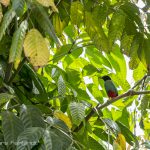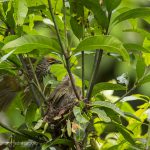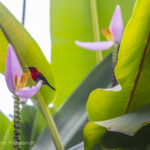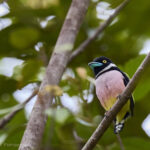Oriental pied hornbill Anthracoceros albirostris (Shaw, 1808) of Borneo (300m ASL)
Anthracoceros albirostris (Shaw, 1808), the Oriental pied hornbill, is a widespread member of Bucerotidae in the Indomalayan region, occurring from northern India and Nepal through Bhutan, Bangladesh and southern China across mainland Southeast Asia to the Malay Peninsula and the Greater Sunda Islands including Sumatra Borneo Java and nearby islands, with re established populations in Singapore. It inhabits subtropical and tropical moist lowland forests and tolerates forest edge secondary growth and some human modified habitats. The species is primarily frugivorous with figs and other fleshy fruits forming a large part of the diet, but it also takes animal prey such as large insects and small vertebrates. Its breeding biology is characteristic of hornbills the female enters a natural tree cavity and seals herself inside with a plaster of mud fruit pulp and droppings leaving a narrow slit while the male provisions her and the chicks until fledging and pairs may reuse nest sites in subsequent years. Two subspecies are commonly recognized, the nominotypical A. a. albirostris from the northern part of the range and A. a. convexus in southern Thailand the Malay Peninsula and the Greater Sundas, although some authorities have treated the latter as a separate species. The global Red List status is Least Concern reflecting a very large range and adaptability, though local declines can result from habitat loss and hunting. The genus name Anthracoceros combines the Ancient Greek anthrax meaning coal and keras meaning horn, and the specific epithet albirostris derives from Latin albus meaning white and rostrum meaning bill, referring to the pale bill and casque of this pied hornbill.





